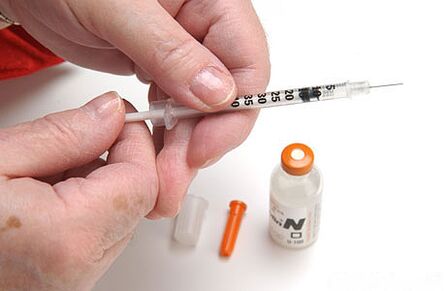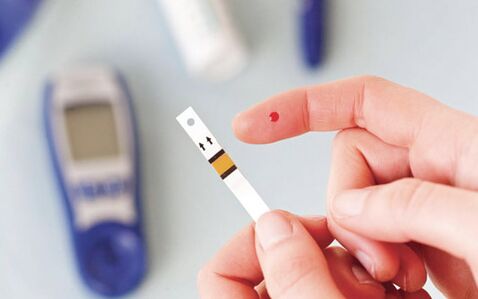Insulin - The hormonal secret of the processor plays an important role and ensures the consistency of blood sugar. Diabetes mellitus is a result of a lack of this hormone. The complications caused by the disease often lead to death. The basic principles for the treatment of diabetes are strictly of nutrition, taking medication or insulin injections, the persecution of the blood level of glucose, and watch your body so as not to miss the first signs of complications.

Pathogenesis of the disease
Diabetes mellitus is a persistent violation of the synthesis of insulin hormone and its interaction with tissues in the body.
Insulin processes the received sugar in glucose and leads it through cell membranes. The hormone thus lowers the degree of blood sugar and supplies the cells with diet. Insulin deficiency with impaired tissue sensitivity means that glucose is not involved in the metabolism and continues to circulate by the body. The biology of carbohydrate metabolism is not only lost, but also fat, protein and water salt.
The increase in sugar increases the amount of lipid fractions in the bloodstream, which contributes to the development of atherosclerosis. The conversion of glucose into glycogen slows down and the body begins to use fat as resources. Fatty acids collapse and ketone bodies seem to cause damage to the central nervous system.
Causes and electricity
Insulin production is disrupted due to the damage to the synthesis beta cells. The main risk factor for diabetes is inheritance that significantly improves the effects of other factors. The likelihood of getting sick increases with age. The causes of diabetes:
- The failure of the immune system. Provokes the attack of cells with a pancreas with protective proteins.
- Obesity. Reduces the reaction of the receptors to the hormone due to a surplus of adipose tissue (the cause of the type of diabetes).
- Pancreas. Name the death of cells that secrete the hormone (pancreatitis, cancer).
- Infection of viruses (pathogens of chickenpox, rubella, influenza).
- Nervous tension.
The disease exists in the role of independent pathology and as a temporary symptom. The causes of diabetes mellitus can be the consequences of the errors of the work of endocrine organs (hyperthyroidism, pheochromocytom). The symptomatic surplus of glucose during pregnancy (including the use of IVF) is called pregnancy diabetes. Hyperglycaemia occurs as a side effect of a longer application of certain medicines (glucocorticoids, estrogen, psychotropic drugs) if they are exposed to toxic substances.
Hyperglycaemia only signals diabetes in the presence of insulin errors, the occurrence of symptoms of a sugar disease.
Types of diabetic pathology

Diabetes mellitus is a violation of carbohydrate and water metabolism in the body.
Classification of WHO determines two leading types of diseases: Insulin -dependent (i -type) and the opposite form -insulin -dependent diabetes (II type). They differ in the reasons for the appearance and details of the pathogenesis, the type of course, their own characteristics of treatment, but the consequences are just as dangerous.
- Insulin -dependent (juvenile) diabetes is caused by autoimmune aggression of the body. The affected endocrine beta cells are unable to produce insulin in the necessary doses, and its constant administration from outside is required. People under the age of 30, thin. The disease suddenly begins, runs quickly and has a difficult course.
- Insulinon -dependent. The causes of diabetes disease of this kind are inheritance and obesity. Insulin can be generated in sufficient quantities, but the cells are not sensitive to it. This is due to a surplus of nutrients. Diabetics over 40 have a complete physique. The acquired diabetes gradually develops and takes place stable. Most patients suffer from this type of illness.
Severity
The severity of the development of diabetes mellitus in the stadium of glycemia, glucosuria, the degree of the functional disorder of the target organs, the presence of complications that show the body's ability to compensate. There is 4 degrees severe. If diabetes goes through to a mild extent, treatment and nutrition are selected correctly. The degree of diabetes and symptoms are described in the table.
| degree | Blood sugar, MMOL/L | Urine readings | Symptoms |
|---|---|---|---|
| 1. (Light) | No more than 7 | Protein is normal, glucosuria is missing | Absent |
| 2. (center) | 7-10 | Glucose up to 40 g/l; Ketosis and ketoacidosis occur regularly | Malfunctions of cardiac activity, visual apparatus, the nervous system, the manifestation of angionicopathy |
| 3. (heavy) | 10-14 | Persistent glucosuria 40 g/l, lots of protein, ketone body | Improved effect on organs, eyesight, pain and deafness in the legs, increase in blood pressure |
| 4. (Superpolat) | 15-25 | More than 50 g/l glucose, intensive proteinuria and ketoacidosis | Strong defeat of all organs, kidney failure, diabetic coma, gait, ulcerative priorities on the feet |
Characteristic symptoms of diabetes

In most cases, the clinical signs of the disease are characterized by a gradual course.
Diabetes in adults may not immediately explain that this leads to the development of complications. Type -i diabetes quickly develop with high glycemia and coma. The intensity of the symptoms of acquired diabetes is connected to the degree of insulin product deficiency, the individuality of the body. You have to go through a test to determine the sugar degree of blood when one of the symptoms occurs:
- an unusual feeling of dry mouth;
- the inability to breastfeed the thirst;
- Improved diuresis - an increase in the amount of urine displayed;
- Fast weight loss or weight gain;
- Itchy and dry skin;
- reduced skin sensitivity on the feet;
- Daubiness, tingling in legs and arms;
- Cramps, heavy in the legs;
- purulent skin processes caused by slow skin regeneration;
- low resistance to infections;
- Constant feeling of hunger;
- vague view;
- increased blood pressure;
- Swelling of the face and legs;
- Pain in the head, passed out;
- Acetone smell of the body;
- Darkness of consciousness;
- Pseudo -peritritine (wrong "sharp stomach").
The consequences of glycemia
Diabetes mellitus is an insidious disease. Excess blood sugar harms blood vessels, causes wall damage. Excess glucose is converted into fat deposits. This leads to obesity and steatog patosis (accumulation of lipids in liver cells). Glucose causes the glycolization of membrane proteins. The oxidative process can cause an impaired protein function and the occurrence of toxicians through products. Defective proteins cause disorders in the structure of organs. The accumulation of toxins and ketones leads to damage to the patient's nervous system to disorders in the mind and in a coma. Excessive blood cholesterol levels are done in the arterial walls in damaged areas and forms plaques of atherosclerosis that contribute to the angiopathies of the eyes, vessels of the legs and other organs.
The grade of blood sugar levels determines the complexity of the course of the disease.
The risk of complications

Complicated diabetes mellitus bears the risk of a sick person's life. Therefore, it is so important to identify the disease in good time and to start treatment. The disease is tightened for 10-15 years. The complications that appear quickly and it is not easy to deal with them. Acute complications with primary diabetes (hypo and hyperglycaemia) are caused by sharp fluctuations in blood sugar. A list of conditions that make the disease of diabetics complicit:
- Hypoglycemia - a sharp drop of glucose of less than 3 mmol/l can lead to a hypoglycemic coma.
- Hyperglycaemia - lifting the sugar indicator over 6 mmol/l ends with a hyperglycemic coma.
- Ketoacidosis - damage to neurons with ketone bodies that cause someone.
- Neuropathy - damage to the nerves of the periphery.
- Diabetic foot, trophic ulcers and deadlines of the lower extremities caused by angiopathy and neuropathy.
- Nephropathy - damage to the small capillaries of the kidneys that disturb the functionality of the urea system.
- Retinopathy - thinning of the vessel walls of the retina.
- Cardiomyopathy - disorders in the heart muscle.
- Encephalopathy - pathology in brain vessels.
Diagnosis
The diagnosis of diabetes determines the type of disease, severity and the presence of lesions of internal organs. Studies can be carried out repeatedly to evaluate the degree of the progress of the disease and the effect of treatment. Diagnostic criteria for diabetes are characteristic signs of diabetes and the lifting of glucose. In order to confirm the diagnosis of confirming urine and blood tests, instrumental studies are carried out:
- Signs of glucose on an empty stomach;
- glycemic profile (daily vibrations);
- Blood at the insulin level;
- an examination of glucose tolerance, the sugar relationship on an empty stomach and after the consumption of carbohydrates;
- Analysis for glycolized hemoglobin;
- Blood for biochemistry;
- General urine analysis to detect glucose, proteins;
- Electrolyte blood test;
- Acetone indicators in urine;
- Eye view;
- Rebell test for kidney damage;
- Ultrasound of the abdomen;
- Cardiogram to check the function of the heart;
- Capillaryoscopy, reuroscopy of the lower extremities determines the degree of defects in the vessels.
In healthy people, the glucose level in the blood lies in the range of 3, 3 to 5, 5 mmol/l.
Treatment of the disease

In the presence of suspected diabetes mellitus, this diagnosis must either be confirmed or refuted.
Diabetes mellitus is a chronic pathology that has to be treated for a lifetime.
The principles of the treatment of diabetes - sugar control in the bloodstream glucometer and the prevention of complications by observing nutrition and taking medication.
An endocrinologist can treat the disease, a cardiologist, a neuropathologist, an ophthalmologist and a vascular surgeon are connected.
Modern treatment methods - medication, nutrition, physical education - slow down the progression of the disease.
Medication
In view of the type of disease, the doctor selects the medicine. Type -1 diabetes mellitus only requires insulin therapy, type -2 diabetes can be treated with sugar. The tablets act on the pancreas and increase the sensitivity of peripheral tissues. Such drugs are used:
- Sulfanilamides.
- Biguanides.
- Insulin preparations of a short and longer effect. Simple insulin is administered up to 2 doses 3-5 times a day and long. Perhaps combined consumption of drugs.
Diet with diabetes
Treatment of diabetes certainly includes a diet with the selection of the calorie content, except easy digestible carbohydrates, sweets. Diabetes needs breakage. At the same time, the ratio of nutrients remains close to the physiological. Sugar is replaced by Xylitol or Sorbit. Diet No. 9 is recommended in the middle and severe forms of the disease. Vegetable soups, low-fat types of fish and meat, acidic dairy products and cheese, cereals (buckwheat, barley hair flakes), fruit, berries of the sweet and acidic taste. You can never eat sdoba, sweets, fat dishes, rice semolina, pasta, grapes, salty, marinated vegetables.
prevention
Type 1 diseases cannot always be influenced because it can cause viral pathogen. The reason for the development of type -2 diabetes is an unhealthy lifestyle, especially in people with hereditary conditions. Prevention measures when diagnosed diagnoses: proper diet in small portions with a minimum of easily digestible carbohydrates and fat, which maintains an optimal body weight. Hyperture is also carried out with the control of blood pressure numbers. At regular intervals you have to donate blood for the content of glucose and lipid blood fractions. Moderate physical activity helps to keep the body in the sound.

























